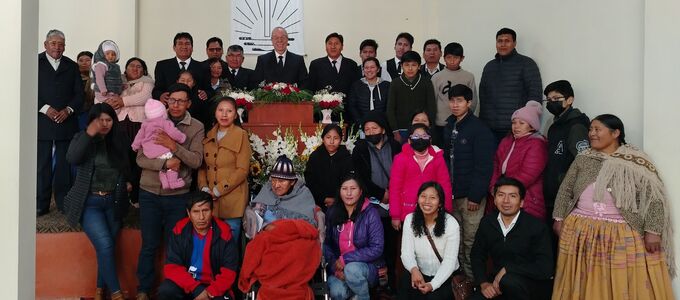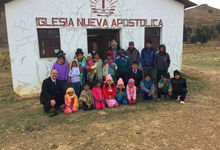Close to heaven
Some congregations in Bolivia are located at altitudes of over 4,000 metres. Hardly any other country is so close to heaven. It is a country that captivates with its geographical diversity. And the members of the Church are as diverse as the country itself.
Bolivia is home to the highest New Apostolic congregations in the world. The Andes extend through western Bolivia, which is home to the world’s highest administrative capital, La Paz. There are four congregations in the city, at an elevation of roughly 4,000 metres above sea level: Del Alto, Villa Bolívar, Quiswaras, and 1º de Mayo.
The beginnings of the Church
La Paz is the cradle of the New Apostolic Church in Bolivia. In March 1972, District Apostle Michael Kraus from Canada officially founded the New Apostolic Church in Bolivia. Apostles Gottfried Schwarzer from Canada, Lorenz Muth from Venezuela, and Juan Carlos Fernández from Uruguay held their first meetings in a hotel in La Paz. The first congregation in La Paz, Alto Miraflores, counted 25 members. Priest Raúl Limachi looked after their spiritual well-being together with Priest Luís Mosqueira Rosi from Venezuela. The congregation still exists today.
From up there, the New Apostolic Church came to the hot and humid lowlands in the east, where the Amazon rainforest begins to the north and the dry savannahs of the Gran Chaco can be found to the south.
Starting in 2004, District Apostle Guillermo Vilor was responsible for Bolivia and the neighbouring country of Brazil. In 2010, District Apostle Raúl Montes de Oca assumed responsibility for these two countries. In 2019 they were merged in the District Apostle Area South America, led by District Apostle Enrique Eduardo Minio. With the retirement of District Apostle Montes de Oca in 2019, his counterpart took over responsibility for Bolivia and Brazil in addition to Argentina, Chile, Paraguay, and Uruguay—almost all of which are direct neighbours of Bolivia.
Diverse congregations in diverse landscapes
Today there are 13 congregations in Bolivia. The majority are concentrated in Santa Cruz de la Sierra. With almost two million inhabitants, it is the largest and one of the most important cities in Bolivia. It is the country’s economic engine. Santa Cruz is the most industrially advanced city in Bolivia. It also offers entertainment, restaurants, museums, and cultural centres. The inhabitants are known as cambas and those among them who are New Apostolic are looking forward to the visit of Chief Apostle Jean-Luc Schneider on 27 September 2024. He will be conducting a divine service in the congregation of Alto San Pedro, to which all the members are invited.
There are also several congregations around La Paz. The city may not be the capital of Bolivia, but it is the country’s seat of government. It is the second largest city in the country and is located in the Andes, not far from the picturesque Lake Titicaca. This is a large freshwater lake in the Andes and is the highest navigable lake in the world. Half of it lies in neighbouring Peru.
There are also congregations around Cochabamba, the third largest city in Bolivia. The city is called the “capital of the valleys” because of its low altitude of around 2,570 metres. And because of its pleasant climate it is also known as the “city of eternal spring”. Other congregations are located in Potosí, which is not far from the dazzling Salar de Uyuni (Uyuni Salt Lake) in the Andes, Trinidad, in the middle of the Amazon, and Tarja in the very south of the country.
A vibrant and rich cultural mix
Bolivia’s inhabitants are as diverse as its cities and climatic zones. Before colonisation by Spain, the country was home to many different cultures with their own languages. There are only around forty of these indigenous peoples left today. Throughout history, it was mainly German-speaking people who migrated to Bolivia.
The fusion of local and European traditions can be seen in the colourful festivals, diverse cuisine, and handicrafts.
This cultural diversity is also reflected in the country’s constitution. In addition to the national languages Spanish, Quechua, Aymara, and Guarani, 33 other languages and their associated ethnic groups are recognised. Since the new constitution came into force in 2009, the state has been called Estado Plurinacional de Bolivia (Plurinational State of Bolivia) to emphasise the country’s multi-ethnic composition and history.
Even if the difference is no longer as pronounced as it was a few years ago, the individual congregations are still very much in touch with the culture of the place in which they are located.
Article info
Author:
Date:
Keywords:
Katrin Löwen
24.09.2024
Bolivia,
Chief Apostle,
Divine service,
Congregational life






















